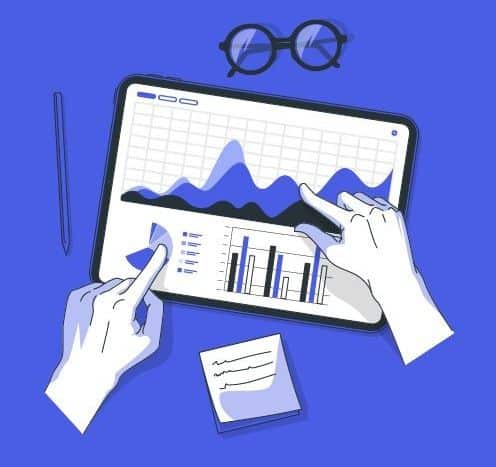Before any house is built, an architect is supposed to draw a plan that will guide the building process. Likewise, a data model should be made before any information system or business application is built.
Now that data is an invaluable asset for business success and can be the differentiator between excelling and failing in business, the concept of data modelling becomes more important.
In this article, you’ll discover what data models are, and familiarize yourself with the data modeling process.
Table of Contents
What are Data Models?
Data models are graphical representations of all important data in an organization, their function, use, and relationship with each other. They can be sketches on a piece of paper, showing entities and their attributes, and how they interact with other entities in the business.
“An entity is any person or thing you collect data about, while attributes are the characteristics of entities.” In a delivery business, for example, the entities could be customers, riders/drivers, transport vehicles, sales reps and customer support agents. Attributes will be the characteristics of those entities; things like name, age, gender, location, type of vehicle, customer ID, etc.
The main idea of a data model is to get a broad view of your most important data, see how they relate, understand how information flows in your business, and how it helps your organization to be more productive.
Using sketches, tables, flowcharts, and other visuals can help you capture vital information about your business at a glance.
Are you a business owner looking to promote your business and stand out among your competitors? We’ve got you covered! Sponsor your business with us today at Insight.ng and take it to the next level.
Importance of Data Models
The importance of a data model for any business application or database management system is similar to the importance of a house plan for any building project. Without a house plan, a building can be chaotic and disorganized as there is nothing to guide the process. There’s no standard to follow.
Similarly, without a data model, developing an information system or a business app can be ineffective, time-consuming, and can lead to a waste of resources. There would also be a higher margin for error, and the likelihood of missing important data.
Therefore, it is important to have a data model for your business. Even if you’re yet to develop an information system or custom business applications, a good data model can guide your choice of third-party applications to help your business run smoothly.
Types of Data Models
It is widely accepted that there are three types of data models. But in practice, they’re more like three phases of the data modelling process.
Nevertheless, let’s check out these three types of data models:
-
Conceptual data model
A conceptual data model is a representation of the overall idea behind an organization’s database or business application. Let’s apply the building and house plan metaphor to make this clear.
Assume you finally decide to build a house for you and your family in Nigeria (your wife, and three kids). The concept behind what you want is “a house that can comfortably accommodate you, your wife, and three children.” In line with this, your house will need at least a parlour, bedrooms, dining room, kitchen, and bathrooms.
If you were to create a conceptual model of your house, it would feature those requirements (different rooms), the users (you and your family), and how they’ll all relate with each other.
Similarly, a conceptual data model shows the data analytics and requirements for a particular database or business application, the entities, and their relationships, without diving into the specifics and technicalities of how it will be implemented.
The conceptual data model aims to answer the question, “What do we need to build the type of database or application that will serve our business effectively?”
It is used during the initial phase of building a database system or application to help business executives and other non-technical stakeholders understand the scope, requirements, and overall use of what is being developed. It also offers them the opportunity to communicate ideas that will improve the system or help solve their business needs.
-
Logical data model
The logical data model is the bridge between concepts and implementation. Logical data models show how data entities are related and describe the data from a technical perspective. For simplicity, let’s go back to the house plan explanation.
Let’s assume that from your conceptual model, you concluded that you need a 4-bedroom apartment. The logical model of your house will dive deeper into the specifics.
What kind of 4-bedroom apartment? Will it be a storey building? How many parlours? Where will the rooms be and how will one part of the house link to another?
The logical data model seeks to answer the question “Now that we have an idea (a concept) of what our database system should do, and what it needs, what is the best layout to help us build a functional database system or business application?”
While the conceptual data model is mostly used to show abstract ideas and an overall view of what the database should do, the logical data model is used by the technical team to lay out concrete plans that will guide the development of the database.
It is like a typical house plan drawn by architects that guide engineers in building a house.
-
Physical data model
Physical data models focus on the implementation of the concrete layout specified by the logical data model.
There are different database management systems and different tools for building a database. The physical data model shows the schema of how a database or business application will be built using a particular database management system or software, and how data will be stored.
It is like a miniature model of your house that gives you a clear picture of what your house will look like when the building is completed.
Data Modeling Techniques
There are different ways of showing a data model. These are called data modelling techniques. They include:
-
Relational model
In a relational model, data is structured into tables. Each table has a primary key that is unique to that table, and foreign keys that connect it to other tables in the database.
The primary key is a unique identity peculiar to each table, while foreign keys are found in multiple tables and are used to connect one table to another.
-
Entity-relationship model (ERM)
This data modelling technique shows different entities in a data model and how they relate to each other. It represents data in the form of a flowchart. This model doesn’t use tables.
-
Object-based data model
Here, the data modelling is arranged around objects and their functions. It can also use tables, but the tables don’t have primary and foreign keys. Instead, it shows the attributes of different objects in a database, their functions, and their relationship with other objects.
-
Hierarchical model
In the hierarchical model, data is arranged in a tree-like pattern, with one
parent and multiple child records. The arrangement in a hierarchical model is called a one-to-many relationship, as one parent record branches out into multiple child records, but each child record can only have one parent.
-
Network data model
The network model is similar to the hierarchical data model. The difference is that in a network model, a child record can have multiple parent records.
Instead of a simple tree-like pattern of the hierarchical model with one parent leading to multiple child records and further branching of child records, this model allows multiple connections, forming a network of interconnected records.
Other data modelling techniques include the semistructured data model, star schema, and dimensional data models.
The choice of which data modelling technique to use depends on the type of database in the works, the skill of the data modeller, and personal taste.
Qualities of a Good Data Model
What makes a good data model? The following are things to look out for:
-
Completeness
Your data model should accommodate all the data needed for the database or application to function effectively.
Leaving out important data in your model will lead to the development of a database system that won’t solve the problems it intended to. Ensure your model fully captures all important data.
-
Non-redundancy
Redundancy means doing the same thing repeatedly, or in the case of data, recording the same facts multiple times. Recording the same facts repeatedly in a working database will consume your storage capacity.
This increases the workload of the database, thereby consuming computing resources that could be used for other vital operations. If you reduce redundancy right from your data modelling process, you’ll have a working database that uses resources optimally.
-
Enforcement of business rules
Does your data model accurately reflect and enforce rules guiding your business’ data? For example, let’s say your business has a rule that your products are only sold to persons who are 18 and above. Your data model should address that.
You can implement that from your data entry process by making it impossible to collect data for a customer below the age of 18.
-
Data reusability
Your data should be organized in a way that it can easily be shared across different teams and applications.
In the words of Graeme C. Simsion, co-author of the book, Data Modeling Essentials, “There are few greater frustrations for system users than to have paid for the capture and storage of data, only to be told that it cannot be made available to suit a new information requirement without extensive and costly reorganization.”
Ensure data is organized independently of any specific application, and that your database can easily be accessed, or data easily exported for other uses.
-
Stability and flexibility
Good data models are developed with a forward-thinking approach. Data models should be able to keep up with possible changes to the business needs.
-
Elegance
Good data models classify data in a reasonably neat and simple way.
-
Communication
Good data models support effective communication among various stakeholders. The concepts represented by the model should be familiar to the users and business specialists. The technical team should also be able to interpret the model correctly.
-
Integration
The proposed database, as represented by the data model should easily fit into the organization’s present and future databases.
Benefits of Data Modelling
Some benefits of data modelling are:
-
Data quality
Creating a good data model before developing a database ensures data quality from the get-go. Poor data quality makes it harder for businesses to benefit from resources spent on collecting and storing data. It also makes the data processing and analysis process more tedious as the business intelligence analyst would have to clean the data first.
With better data quality, businesses can get down to the most important insights from their data without much hassle.
-
Better performance
Remember the physical data modelling that focuses on the implementation of the logical data model?
Data modelling takes away the trial and error you’d have to go through if you’re just building databases without a clear plan to follow. It ensures better performance of your database or applications that rely on your data.
-
Better documentation
Good documentation makes collaboration easy. New members/employees can easily understand the database and how it works.
-
Improved data communication
Data modelling allows for clear communication amongst stakeholders in an organization, ensuring everyone is on the same page throughout the development process and beyond.
-
Regulatory compliance
As seen from one of the qualities of good data models, data modelling can help enforce compliance with regulations in your industry or location.
Would you like to read business insights like this more often? Subscribe to our newsletter and let’s keep you updated.
Conclusion
As you’ve seen, creating a good data model helps you lay the groundwork and set the stage for a foolproof database that effectively solves the problems it’s intended for. It is important to keep all major stakeholders in the know to ensure all requirements are captured.
I’ll leave you with the words of Graeme C. Simsion. “Data modelling is not optional; no database was ever built without at least an implicit model, just as no house was ever built without a plan.”
Edited by Priscilla Ajayi.
About Author

-
Tari Yousuo is an SEO specialist and content writer, writing about Tech and IT, Cloud Computing, AI, and Marketing.
When he's not digging deep into tech and the digital world, you can find him absorbing the beauty of nature or playing with poetry.
Latest entries


 CareerApril 18, 2024The Impacts of AI and Automation on Different Careers in Nigeria
CareerApril 18, 2024The Impacts of AI and Automation on Different Careers in Nigeria

